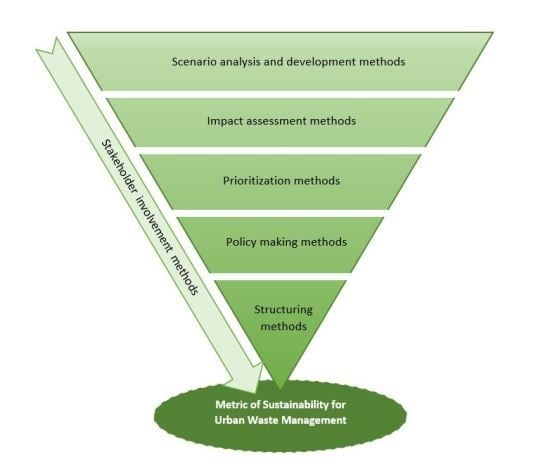A Holistic Sustainability Framework for Waste Management in European Cities: Concept Development
Abstract
1. Introduction
1.1. From Linear to Circular Economy
1.2. Responsibilities and Current Practice of Waste Management in European Cities
1.3. Sustainable Urban Waste and Resource Management
2. State-of-the-Art Overview of Sustainability Frameworks in the Context of Waste Management
- Key objectives: the aim(s) of the study.
- Urban/city focus: framework especially made to inform local authorities?
- Methods/tools: which methods, indicators and eventual tools used.
- Life cycle thinking approach: whether life cycle thinking was integrated.
- Multi-dimensional: social, economic, political, technical, legal, environmental, or other.
- Temporal variability: in terms of data collection, impact assessment, or other.
- Spatial variability: in terms of data collection, impact assessment, or other.
- Stakeholder involvement: during data collection, impact assessment, criteria selection, etc.
3. Development of a Holistic Sustainability Framework for European Urban Waste Management
3.1. Holistic Sustainability for Urban Waste Management: What Does It Mean?
3.2. Selection of Methods According to the Objectives
3.2.1. Classification: Types of Methods
3.2.2. Retained Methods
Scenario Analysis and Development Methods
Methods for Impact Assessment
Methods to Prioritize
Policy Making Methods (Polmak)
Stakeholder Involvement Methods (SI)
Structuring Methods
3.3. Sustainability Framework
4. Conclusions
5. Discussions and Recommendations for Future Developments
5.1. Data Availability and Quality
5.2. Life Cycle Sustainability Assessment as A Tool for Policy Making
5.3. Goal and Scope of the Conceptual Framework
Supplementary Materials
Author Contributions
Funding
Acknowledgments
Conflicts of Interest
References
- Hamilton, H.; Peverill, M.S.; Müller, D.; Brattebø, H. Assessment of Food Waste Prevention and Recycling Strategies Using a Multilayer Systems Approach. Environ. Sci. Technol. 2015, 49, 13937–13945. [Google Scholar] [CrossRef] [PubMed]
- Yuan, H.; Huang, Z.; Xu, P. A framework for eco-efficiency of C&D waste management. Procedia Environ. Sci. 2016, 31, 855–859. [Google Scholar] [CrossRef]
- Ellen MacArthur Foundation. Cities in the Circular Economy: An Initial Exploration, 2017. Available online: https://www.ellenmacarthurfoundation.org/publications/cities-in-the-circular-economy-an-initial-exploration (accessed on 18 January 2018).
- De Wit, M.; Hoogzaad, J.; Ramkumar, S.; Friedl, H.; Douma, A. The Circularity Gap Report: An Analysis of the Circular State of the Global Economy; Circle Economy: Amsterdam, The Netherlands, 2018. [Google Scholar]
- Eurostat. Available online: http://ec.europa.eu/eurostat/statistics-explained/index.php/Waste_statistics (accessed on 10 December 2017).
- Ekvall, T.; Assefa, G.; Bjorklund, A.; Eriksson, O.; Finnveden, G. What life-cycle assessment does and does not do in assessments of waste management. Waste Manag. 2007, 27, 989–996. [Google Scholar] [CrossRef] [PubMed]
- Rockström, J.; Steffen, W.; Noone, K.; Persson, A.; Chapin, F.S.; Lambin, E.; Lenton, T.; Scheffer, M.; Folke, C.; Schellnhuber, H.J.; et al. A safe operating space for humanity. Nature 2009, 461, 472–475. [Google Scholar] [CrossRef] [PubMed]
- European Commission (EC). Directive 2008/98/EC on Waste of the European Parliament and of the Council of 19 November 2008 on Waste and Repealing Certain Directives—Official Journal of the European Union L 312/3; European Commission (EC): Brussels, Belgium, 2008.
- Ellen MacArthur Foundation; Granta. Circular Indicators: An Approach to Measuring Circularity. Available online: https://www.ellenmacarthurfoundation.org/assets/downloads/insight/Circularity-Indicators_Methodology_May2015.pdf (accessed on 12 January 2018).
- Huysman, S.; Debaveye, S.; Schaubroeck, T.; De Meester, S.; Ardente, F.; Mathieux, F.; Dewulf, J. The recyclability benefit rate of closed-loop and open-loop systems: A case study on plastic recycling in Flanders. Resour. Conserv. Recycl. 2015, 101, 53–60. [Google Scholar] [CrossRef]
- European Environment Agency (EEA). The European Environment—State and Outlook 2015: Synthesis Report; European Environment Agency: Copenhagen, Denmark, 2015.
- European Commission (EC). Being Wise with Waste: The EU’s Approach to Waste Management; European Commission: Brussels, Belgium, 2010.
- Weiland, U. Land and Landscape Management in Europe—Common Report 2011; Land and Landscape Management in Europe—Joint Master Programme (JMP) Sustainable Development; University of Leipzig: Leipzig, Germany, 2011. [Google Scholar]
- Kasanko, M.; Barredo, J.I.; Lavalle, C.; McCormick, N.; Demicheli, L.; Sagris, V.; Brezger, A. Are European cities becoming dispersed? A comparative analysis of 15 European urban areas. Landsc. Urban Plan. 2006, 77, 111–130. [Google Scholar] [CrossRef]
- Stanisavljevic, N.; Brunner, P.H. Combination of material flow analysis and substance flow analysis: A powerful approach for decision support in waste management. Waste Manag. Res. 2014, 32, 733–744. [Google Scholar] [CrossRef] [PubMed]
- Shmelev, S.E.; Powell, J.R. Ecological–economic modelling for strategic regional waste management systems. Ecol. Econ. 2006, 59, 115–130. [Google Scholar] [CrossRef]
- Balaman, Y.; Wright, D.; Scott, J.; Matopoulos, A. Network design and technology management for waste to energy production: An integrated optimization framework under the principles of circular economy. Energy 2018, 143, 911–933. [Google Scholar] [CrossRef]
- Chen, P.; Liu, K.; Ma, H. Resource and waste-stream modelling and visualization as decision support tools for sustainable materials management. J. Clean. Prod. 2017, 150, 16–25. [Google Scholar] [CrossRef]
- Chong, Y.T.; Teo, K.M.; Tang, L.C. A Lifecycle-based sustainability indicator framework for waste-to-energy systems and a proposed metric of sustainability. Renew. Sustain. Energy Rev. 2016, 56, 797–809. [Google Scholar] [CrossRef]
- Corder, G.D.; McLellan, B.C.; Green, S.R. Delivering solutions for resource conservation and recycling into project management systems through SUSOP. Miner. Eng. 2012, 29, 47–57. [Google Scholar] [CrossRef]
- Cristobal, J.; Limleamthong, P.; Manfredi, S.; Guillen-Gosalbez, G. Methodology for combined use of data envelopment analysis and life cycle assessment applied to food waste management. J. Clean. Prod. 2016, 135, 158–168. [Google Scholar] [CrossRef]
- Habibi, F.; Asadi, E.; Sadjadi, S.J.; Barzinpour, F. A multi-objective robust optimization model for site-selection and capacity allocation of municipal solid waste facilities: A case study in Tehran. J. Clean. Prod. 2017, 166, 816–834. [Google Scholar] [CrossRef]
- Iacovidou, I.; Millward-Hopkins, J.; Busch, J.; Purnell, P.; Velis, C.; Hahladakis, J.; Zwirner, O.; Brown, A. A pathway to circular economy: Developing a conceptual framework for complex value assessment of resources recovered from waste. J. Clean. Prod. 2017, 168, 1279–1288. [Google Scholar] [CrossRef]
- Inghels, D.; Dullaert, W.; Bloemhof, J. A model for improving sustainable green waste recovery. Resour. Conserv. Recycl. 2016, 110, 61–73. [Google Scholar] [CrossRef]
- Khalili, N.; Duecker, S. Application of multi-criteria decision analysis in design of sustainable environmental management system framework. J. Clean. Prod. 2013, 47, 188–198. [Google Scholar] [CrossRef]
- Liu, G.; Yang, Z.; Chen, B.; Zhang, L. Modelling a thermodynamic-based comparative framework for urban sustainability: Incorporating economic and ecological losses into emergy analysis. Ecol. Model. 2013, 252, 280–287. [Google Scholar] [CrossRef]
- Lupo, T.; Cusumano, M. Towards more equity concerning quality of Urban Waste Management services in the context of cities. J. Clean. Prod. 2018, 171, 1324–1341. [Google Scholar] [CrossRef]
- Mostafa, S.; Dumrak, J. Waste elimination for manufacturing sustainability. Procedia Manuf. 2015, 2, 11–16. [Google Scholar] [CrossRef]
- Nixon, J.D.; Dey, P.K.; Ghosh, S.K.; Davies, P.A. Evaluation of options for energy recovery from municipal solid waste in India using the hierarchical analytical network process. Energy 2013, 59, 215–223. [Google Scholar] [CrossRef]
- Ohnishi, S.; Dong, H.; Geng, Y.; Fujii, M.; Fujita, T. A comprehensive evaluation on industrial & urban symbiosis by combining MFA, carbon footprint and emergy methods—Case of Kawasaki, Japan. Ecol. Indic. 2017, 73, 513–524. [Google Scholar] [CrossRef]
- Papargyropoulou, E.; Lozano, R.; Steinberger, J.; Wright, N.; Ujang, Z. The food waste hierarchy as a framework for the management of food surplus and food waste. J. Clean. Prod. 2014, 76, 106–115. [Google Scholar] [CrossRef]
- Scheel, C. Beyond sustainability. Transforming industrial zero-valued residues into increasing economic returns. J. Clean. Prod. 2016, 131, 376–386. [Google Scholar] [CrossRef]
- Shekdar, A. Sustainable solid waste management: An integrated approach for Asian countries. Waste Manag. 2009, 29, 1438–1448. [Google Scholar] [CrossRef] [PubMed]
- Souza, R.G.; Rosenhead, J.; Salhofer, S.P.; Valle, R.A.B.; Lins, M.P.E. Definition of sustainability impact categories based on stakeholder perspectives. J. Clean. Prod. 2015, 105, 41–51. [Google Scholar] [CrossRef]
- Steingrímsson, J.G.; Seliger, G. Conceptual framework for near-to-site waste cycle design. Procedia CIRP 2014, 15, 272–277. [Google Scholar] [CrossRef]
- Wilson, D.; Rodic, L.; Cowing, M.; Velis, C.; Whiteman, A.; Scheinberg, A.; Vilches, R.; Masterson, D.; Stretz, J.; Oelz, B. ‘Wasteaware’ benchmark indicators for integrated sustainable waste management in cities. Waste Manag. 2015, 35, 329–342. [Google Scholar] [CrossRef] [PubMed]
- Lazarevic, D.; Buclet, N.; Brandt, N. The application of life cycle thinking in the context of European waste policy. J. Clean. Prod. 2012, 29–30, 199–207. [Google Scholar] [CrossRef]
- Cimpan, C.; Rothmann, M.; Hamelin, L.; Wenzel, H. Towards increased recycling of household waste: Documenting cascading effects and material efficiency of commingled recyclables and biowaste collection. J. Environ. Manag. 2015, 157, 69–83. [Google Scholar] [CrossRef] [PubMed]
- Grasland, C.; Europe in the World. Contribution of ESPON to EU Policies, Brussels. Available online: https://www.espon.eu/sites/default/files/attachments/espon_ws_06052009_grasland_europe_in_the_world.pdf (accessed on 10 November 2017).
- Hazen, E.; Suryan, R.; Santora, J.; Bograd, S.; Watanuki, Y.; Wilson, R. Scales and mechanisms of marine hotspot formation. Mar. Ecol. Prog. Ser. 2013, 487, 177–183. [Google Scholar] [CrossRef]
- European Commission (EC). The World Summit on Sustainable Development People, Planet, Prosperity; European Commission (EC): Brussels, Belgium, 2012.
- Yuan, C.; Wang, E.; Zhaj, Q.; Yang, F. Temporal discounting in life cycle assessment: A critical review and theoretical framework. Environ. Impact Assess. 2015, 51, 23–31. [Google Scholar] [CrossRef]
- Emmott, N.; Bär, S.; Kraemer, A. Policy review: IPPC and the Sevilla process. Eur. Environ. 2000, 10, 204–207. [Google Scholar] [CrossRef]
- Shortall, R.; Davidsdottir, B.; Axelsson, G. Development of a sustainability framework for geothermal energy projects. Energy Sustain. Dev. 2015, 27, 28–45. [Google Scholar] [CrossRef]
- Burdett, L.; Cooksey, E.; Christie, I.; Wehrmmey, W.; Chenoweth, J.; Clift, R. Environment Agency Scenarios 2030; Science Report SC050002/SR1; Environment Agency: Bristol, UK, 2006.
- Czaplicka-Kolarz, K.; Korol, J.; Ludwik-Pardała, M.; Ponikiewska, K. Material and Energy Flow Analysis (MEFA) of the unconventional method of electricity production coal gasification. J. Sustain. Min. 2014, 13, 41–47. [Google Scholar] [CrossRef]
- Arena, U.; Di Gregorio, F. A waste management planning based on substance flow analysis. Resour. Conserv. Recycl. 2014, 85, 54–66. [Google Scholar] [CrossRef]
- Eckelman, M.J.; Chertow, M.R. Using Material Flow Analysis to Illuminate Long-Term Waste Management Solutions in Oahu, Hawaii. J. Ind. Ecol. 2009, 13, 758–774. [Google Scholar] [CrossRef]
- Zhang, Y. Urban metabolism: A review of research methodologies. Environ. Pollut. 2013, 178, 463–473. [Google Scholar] [CrossRef] [PubMed]
- Reed, M.; Graves, A.; Dandy, N.; Posthumus, H.; Hubacek, K.; Morris, J.; Prell, C.; Quinn, C.; Stringer, L. Who’s in and why? A typology of stakeholder analysis methods for natural resource management. J. Environ. Manag. 2009, 90, 1933–1949. [Google Scholar] [CrossRef] [PubMed]
- Sun, L.; Li, H.; Dong, L.; Fang, K.; Ren, J.; Geng, Y.; Fuiji, M.; Zhang, W.; Zhang, N.; Liu, Z. Eco-benefits assessment on urban industrial symbiosis based on material flows analysis and emergy evaluation approach: A case of Liuzhou city, China. Resour. Conserv. Recycl. 2016, 119, 78–88. [Google Scholar] [CrossRef]
- Vanderhaegen, M.; Muro, E. Contribution of a European spatial data infrastructure to the effectiveness of EIA and SEA studies. Environ. Impact Assess. 2005, 25, 123–142. [Google Scholar] [CrossRef]
- Wandl, A.; Nadin, V.; Zonneveld, W.A.M.; Rooij, R.M. Beyond urban-rural classifications: Characterising and mapping territories-in-between across Europe. Landsc. Urban Plan. 2014, 130, 50–63. [Google Scholar] [CrossRef]
- Dyson, B.; Chang, N. Forecasting municipal solid waste generation in a fast-growing urban region with system dynamics modelling. Waste Manag. 2005, 25, 669–679. [Google Scholar] [CrossRef] [PubMed]
- Katsamaki, A.; Willems, S.; Diamadopoulos, E. Time series analysis of municipal solid waste generation rates. J. Environ. Eng. 1998, 124, 178–183. [Google Scholar] [CrossRef]
- Navarro-Esbrı, J.; Diamadopoulos, E.; Ginestar, D. Time series analysis and forecasting techniques for municipal solid waste management. Resour. Conserv. Recycl. 2002, 35, 201–214. [Google Scholar] [CrossRef]
- European Commission (EC). Final Report. Monitoring Foresight Activities in Europe and the Rest of the World; Publications Office of the European Union: Luxembourg, 2009. [Google Scholar]
- Hauschild, M.; Rosenbaum, R.; Olsen, S. Life Cycle Assessment. Theory and Practice; Springer International Publishing AG: Cham, Switzerland, 2018; p. 1215. ISBN 978-3-319-56474-6. [Google Scholar]
- Allesch, A.; Brunner, P. Assessment methods for solid waste management: A literature review. Waste Manag. Res. 2014, 32, 461–473. [Google Scholar] [CrossRef] [PubMed]
- Morrissey, A.J.; Browne, J. Waste management models and their application to sustainable waste management. Waste Manag. 2004, 24, 297–308. [Google Scholar] [CrossRef] [PubMed]
- Finnveden, G.; Moberg, A. Environmental systems analysis tools—An overview. J. Clean. Prod. 2005, 13, 1165–1173. [Google Scholar] [CrossRef]
- Rapti-Caputo, D.; Sdao, F.; Masi, S. Pollution risk assessment based on hydrogeological data and management of solid waste landfills. Eng. Geol. 2006, 85, 122–131. [Google Scholar] [CrossRef]
- Petts, J. Handbook of Environmental Impact Assessment: Volume 2: Impact and Limitations; Blackwell Science Ltd.: Oxford, UK, 1999; p. 450. ISBN 0-632-04771-2. [Google Scholar]
- Benetto, E.; Tiruta-Barna, L.; Perrodin, Y. Combining lifecycle and risk assessments of mineral waste reuse scenarios for decision making support. Environ. Impact Assess. 2007, 27, 266–285. [Google Scholar] [CrossRef]
- Kloepffer, W. Life cycle sustainability assessment of products. Int. J. Life Cycle Assess. 2008, 13, 89–95. [Google Scholar] [CrossRef]
- Rebitzer, G.; Ekvall, T.; Frischknecht, R.; Hunkeler, D.; Noms, G.; Rydberg, T.; Schmidt, W.P.; Suh, S.; Weidema, B.; Pennington, D. Life Cycle Assessment: Part 1: Framework, Goals and Scope definition, inventory analysis, and applications. Environ. Int. 2004, 30, 701–720. [Google Scholar] [CrossRef] [PubMed]
- International Organization for Standardization. ISO 14040—Environmental Management—Life Cycle Assessment—Goal and Scope—Definition and Inventory Analysis; International Organization for Standardization: Geneva, Switzerland, 2006; p. 20. [Google Scholar]
- International Organization for Standardization. ISO 14044—Environmental Management—Life Cycle Assessment—Requirements and Guideline; International Organization for Standardization: Geneva, Switzerland, 2006; p. 46. [Google Scholar]
- European Commission (EC). Analysis of Existing Environmental Footprint Methodologies for Products and Organizations: Recommendations, Rationale, and Alignment, 2012. Available online: http://ec.europa.eu/environment/eussd/pdf/Deliverable.pdf (accessed on 16 November 2017).
- Guineé, J.B.; Gorée, M.; Heijungs, R.; Huppes, G.; Kleijn, R.; de Koning, A.; van Oers, L.; Wegener Sleeswijk, A.; Suh, S.; Udo de Haes, H.A.; et al. Handbook on Life Cycle Assessment. Operational Guide to the ISO Standards. Int. J. Life Cycle Assess. 2002, 7, 311–313. [Google Scholar] [CrossRef]
- European Commission (EC). International Reference Life Cycle Data System (ILCD) Handbook—General Guide for Life Cycle Assessment. Available online: http://publications.jrc.ec.europa.eu/repository/bitstream/JRC48157/ilcd_handbook-general_guide_for_lca-detailed_guidance_12march2010_isbn_fin.pdf (accessed on 6 October 2017).
- Weidema, B.; Ekvall, T.; Heijungs, R. Guidelines for Application of Deepened and Broadened LCA; Deliverable D18 of Work Package 5 of the CALCAS Project. Available online: http://www.leidenuniv.nl/cml/ssp/publications/calcas_report_d18.pdf (accessed on 26 June 2018).
- Gentil, E.; Damgaard, A.; Hauschild, M.; Finnveden, G.; Eriksson, O.; Thorneloe, S.; Kaplan, P.O.; Barlaz, M.; Muller, O.; Matsui, Y.; et al. Models for waste life cycle assessment: Review of technical assumptions. Waste Manag. 2010, 30, 2636–2648. [Google Scholar] [CrossRef] [PubMed]
- Brander, M.; Tipper, R.; Hutchinson, C.; Davis, G. Consequential and Attributional Approaches to LCA: A Guide to Policy Makers with Specific Reference to Greenhouse Gas LCA of Biofuels; Ecometrica Press: London, UK, 2009; Available online: http://www.ecometrica.com/assets//approachesto_LCA3_technical.pdf (accessed on 12 January 2018).
- Laurent, A.; Bakas, I.; Clavreul, J.; Bernstad, A.; Niero, M.; Gentil, E.; Hauschild, M.; Christensen, T. Review of LCA studies of solid waste management systems—Part I: Lessons learned and perspectives. Waste Manag. 2014, 34, 573–588. [Google Scholar] [CrossRef] [PubMed]
- Laurent, A.; Clavreul, J.; Bernstad, A.; Bakas, I.; Niero, M.; Gentil, E.; Christensen, T.; Hauschild, M. Review of LCA studies of solid waste management systems—Part II: Methodological guidance for a better practice. Waste Manag. 2014, 34, 589–606. [Google Scholar] [CrossRef] [PubMed]
- Astrup, T.F.; Tonini, D.; Turconi, R.; Boldrin, A. Life cycle assessment of thermal Waste-to-Energy technologies: Review and recommendations. Waste Manag. 2015, 37, 104–115. [Google Scholar] [CrossRef] [PubMed]
- Clavreul, J.; Guyonnet, D.; Christensen, D. Quantifying uncertainty in LCA-modelling of waste management systems. Waste Manag. 2012, 32, 2482–2495. [Google Scholar] [CrossRef] [PubMed]
- Bisinella, A.B.; Ahmadi, A.; Tiruta-Barna, L.; Spérandio, M. Feasibility of rigorous multi-objective optimization of wastewater management and treatment plants. Chem. Eng. Res. Des. 2016, 115, 394–406. [Google Scholar] [CrossRef]
- Kobayashi, Y.; Peters, G.; Khan, S. Towards More Holistic Environmental Impact Assessment: Hybridisation of Life Cycle Assessment and Quantitative Risk Assessment. Procedia CIRP 2015, 29, 378–383. [Google Scholar] [CrossRef]
- Taelman, S.E.; Schaubroeck, T.; De Meester, S.; Boone, L.; Dewulf, J. Accounting for land use in life cycle assessment: The value of NPP as a proxy indicator to assess land use impacts on ecosystems. Sci. Total Environ. 2016, 550, 143–156. [Google Scholar] [CrossRef] [PubMed]
- Levasseur, A.; Lesage, P.; Margni, M.; Deschenes, L.; Samson, R. Considering Time in LCA: Dynamic LCA and Its Application to Global Warming Impact Assessments. Environ. Sci. Technol. 2010, 44, 3169–3174. [Google Scholar] [CrossRef] [PubMed]
- Martinez-Sanchez, V.; Kromann, M.; Astrup, T. Life cycle costing of waste management systems: Overview, calculation principles and case studies. Waste Manag. 2015, 36, 343–355. [Google Scholar] [CrossRef] [PubMed]
- Hunkeler, D.; Lichtenvort, K.; Rebitzer, G. Environmental Life Cycle Costing; CRC Press: Boca Raton, FL, USA, 2008; p. 232. ISBN 9781420054705. [Google Scholar]
- Benoît, C.; Mazijn, B. Guidelines for Social Life Cycle Assessment of Products: A Social and Socio-Economic LCA Code of Practice; United Nations Environment Programme: Nairobi, Kenya, 2009. [Google Scholar]
- Ciroth, A.; Eisfeldt, F. PSILCA—A Product Social Impact Life Cycle Assessment Database, Database Version 1.0; Documentation. Version 1.1; Greendelta: Berlin, Germany, 2016. [Google Scholar]
- Moreno, R.; Lévová, T.; Bourgault, G.; Wernet, G. Documentation of Changes Implemented in Ecoinvent Data 3.1; Ecoinvent: Zurich, Switzerland, 2014. [Google Scholar]
- Hummel, M.; Bridges, J.; IJzerman, M. Group Decision Making with the Analytic Hierarchy Process in Benefit-Risk Assessment: A Tutorial. Patient 2014, 7, 129–140. [Google Scholar] [CrossRef] [PubMed]
- Vadenbo, C.; Tonini, D.; Astrup, T.F. Environmental Multi-objective Optimization for the Use of Biomass Resources for Energy. Environ. Sci. Technol. 2017, 51, 3575–3583. [Google Scholar] [CrossRef] [PubMed]
- Hanney, S.; Conzalez-Block, M.; Buxton, M.; Kogan, M. The utilisation of health research in policy-making: Concepts, examples and methods of assessment. Health Res. Policy Syst. 2003, 1, 1–28. [Google Scholar] [CrossRef]
- Brownson, R.; Chriqui, J.; Stamatakis, K. Understanding Evidence-Based Public Health Policy. Am. J. Public Health 2009, 99, 1576–1583. [Google Scholar] [CrossRef] [PubMed]
- Contreras, F.; Hanaki, K.; Aramaki, T.; Connors, S. Application of analytical hierarchy process to analyze stakeholders preferences for municipal solid waste management plans, Boston, USA. Resour. Conserv. Recycl. 2008, 52, 979–991. [Google Scholar] [CrossRef]
- Lewison, R.; Rudd, M.; Al-Hayek, W.; Baldwin, C.; Beger, M.; Lieske, S.; Jones, C.; Satumanatpan, S.; Junchompoo, C.; Hines, E. How the DPSIR framework can be used for structuring problems and facilitating empirical research in coastal systems. Environ. Sci. Policy 2016, 56, 110–119. [Google Scholar] [CrossRef]
- European Environment Agency (EEA). Environmental Indicators: Typology and Overview; Technical Report No 25; Environment Directorate-General: Copenhagen, Denmark, 1999.
- Schneider, P.; Anh, L.H.; Wagner, J.; Reichenbach, J.; Hebner, A. Solid Waste Management in Ho Chi Minh City, Vietnam: Moving towards a Circular Economy? Sustainability 2017, 9, 286. [Google Scholar] [CrossRef]
- Greyl, L.; Vegni, S.; Natalicchio, M.; Cure, S.; Ferretti, J. The Waste Crisis in Campania, Italy. Available online: http://www.ceecec.net/case-studies/waste-crisis-in-campania-italy/ (accessed on 12 November 2017).
- Kristensen, P. The DPSIR Framework. In Proceedings of the Workshop on a Comprehensive/Detailed Assessment of the Vulnerability of Water Resources to Environmental Change in Africa Using River Basin Approach, UNEP Headquarters, Nairobi, Kenya, 27–29 September 2004. [Google Scholar]
- Vadenbo, C.; Hellweg, S.; Guillén-Gosálbez, G. Multi-objective optimization of waste and resource management in industrial networks—Part I: Model description. Resour. Conserv. Recycl. 2014, 89, 52–63. [Google Scholar] [CrossRef]
- Thabrew, L.; Wiek, A.; Ries, R. Environmental decision making in multi-stakeholder contexts: Applicability of life cycle thinking in development planning and implementation. J. Clean. Prod. 2009, 17, 67–76. [Google Scholar] [CrossRef]
- European Commission (EC). The Raw Materials Initiative—Meeting our Critical Needs for Growth and Jobs in Europe, COM/2008/699; European Commission (EC): Brussels, Belgium, 2008.
- European Commission (EC). Closing the Loop—An EU Action Plan for the Circular Economy, COM/2015/0614; European Commission (EC): Brussels, Belgium, 2015.
- Manfredi, S.; Pant, R. Supporting Environmentally Sound Decisions for Waste Management; A Technical Guide to Life Cycle Thinking (LCT) and Life Cycle Assessment (LCA) for Waste Experts and LCA Practitioners; European Union: Luxembourg, 2011. [Google Scholar]
- Zhang, Y.; Zheng, H.; Fath, B.; Liu, H.; Yang, Z.; Liu, G.; Su, M. Ecological network analysis of an urban metabolic system based on input–output tables: Model development and case study for Beijing. Sci. Total Environ. 2014, 468–469, 642–653. [Google Scholar] [CrossRef] [PubMed]
- Roy, M.; Curry, R.; Ellis, G. Spatial allocation of material flow analysis in residential developments: A case study of Kildare County, Ireland. J. Environ. Plan. Manag. 2014, 58, 1–21. [Google Scholar] [CrossRef]
- Rosenbaum, R. Chapter 40. Overview of Existing LCIA Methods—Annex to chapter 10. In Life Cycle Assessment: Theory and Practice; Hauschild, M., Rosenbaum, R., Olsen, S., Eds.; Springer International Publishing: Cham, Switzerland, 2018; ISBN 978-3-319-56475-3. [Google Scholar]
- Heijungs, R.; Huijbregts, M. A Review of Approaches to Treat Uncertainty in LCA. In Proceedings of the 2nd International Congress on Environmental Modelling and Software, Osnabrück, Germany, 14–17 June 2004. [Google Scholar]
- Guinée, J.B. Life Cycle Sustainability Assessment: What Is It and What Are Its Challenges. In Taking Stock of Industrial Ecology; Clift, R., Druckman, A., Eds.; Springer International Publishing: Cham, Switzerland, 2016; ISBN 978-3-319-20571-7. [Google Scholar]
- Valdivia, S.; Ugaya, C.M.L.; Sonnemann, G.; Hildenbrand, J. Towards a Live Cycle Sustainability Assessment: Making Informed Choices on Products; United Nations Environment Programme: Paris, France, 2011. [Google Scholar]
- Marchand, M.; Aissani, L.; Mallard, P.; Béline, F.; Réveret, J.P. Odour and Life Cycle Assessment (LCA) in Waste Management: A Local Assessment Proposal. Waste Biomass Valoriz. 2013, 4, 607–617. [Google Scholar] [CrossRef]
- Taelman, S.E.; De Meester, S.; Schaubroeck, T.; Sakshaug, E.; Alvarenga, R.; Dewulf, J. Accounting for the occupation of the marine environment as a natural resource in life cycle assessment: An exergy based approach. Resour. Conserv. Recycl. 2014, 91, 1–10. [Google Scholar] [CrossRef]
- Weidema, B. In search of a consistent solution to allocation of joint production. J. Ind. Ecol. 2017, 22, 252–262. [Google Scholar] [CrossRef]
- Weidema, B.; Pizzol, M.; Schmidt, J.; Thoma, G. Attributional or consequential Life Cycle Assessment: A matter of social responsibility. J. Clean. Prod. 2018, 174, 305–314. [Google Scholar] [CrossRef]
- Martin, E.; Chester, M.; Vergara, S. Attributional and Consequential Life-cycle Assessment in Biofuels: A Review of Recent Literature in the Context of System Boundaries. Curr. Sustain. Renew. Energy Rep. 2015, 2, 82–89. [Google Scholar] [CrossRef]
- Pradel, M.; Aissani, L.; Villot, J.; Baudez, J.C.; Laforest, V. From waste to added value product: Towards a paradigm shift in life cycle assessment applied to wastewater sludge—A review. J. Clean. Prod. 2016, 131, 60–75. [Google Scholar] [CrossRef]
- Weidema, B.; Bauer, C.; Hischier, R.; Mutel, C.; Nemecek, T.; Reinhard, J.; Vadenbo, C.O.; Wernet, G. Overview and Methodology Data Quality Guideline for the Ecoinvent Database Version 3; Ecoinvent Report 1(v3); The Ecoinvent Centre: St. Gallen, Switzerland, 2013. [Google Scholar]
- Allacker, K.; Mathieux, F.; Pennington, D.; Pant, R. The search for an appropriate end-of-life formula for the purpose of the European Commission Environmental Footprint initiative. Int. J. Life Cycle Assess. 2017, 22, 1441–1458. [Google Scholar] [CrossRef]
- Lasvaux, S.; Gantner, J.; Wittstock, B.; Bazzana, M.; Schiopu, N.; Saunders, T.; Gazulla, C.; Mundy, J.A.; Sjöström, C.; Fullana-i-Palmer, P.; et al. Achieving consistency in life cycle assessment practice within the European construction sector: The role of the EeBGuide InfoHub. Int. J. Life Cycle Assess. 2014, 19, 1783–1793. [Google Scholar] [CrossRef]
- Fontes, J. Handbook for Product Social Impact Assessment, version 3.0; PRé Sustainability: Amersfoort, The Netherlands, 2016. [Google Scholar]
- Säynäjoki, A.; Heinonen, J.; Junnila, S.; Horvath, A. Can life-cycle assessment produce reliable policy guidelines in the building sector? Environ. Res. Lett. 2017, 12, 013001. [Google Scholar] [CrossRef]
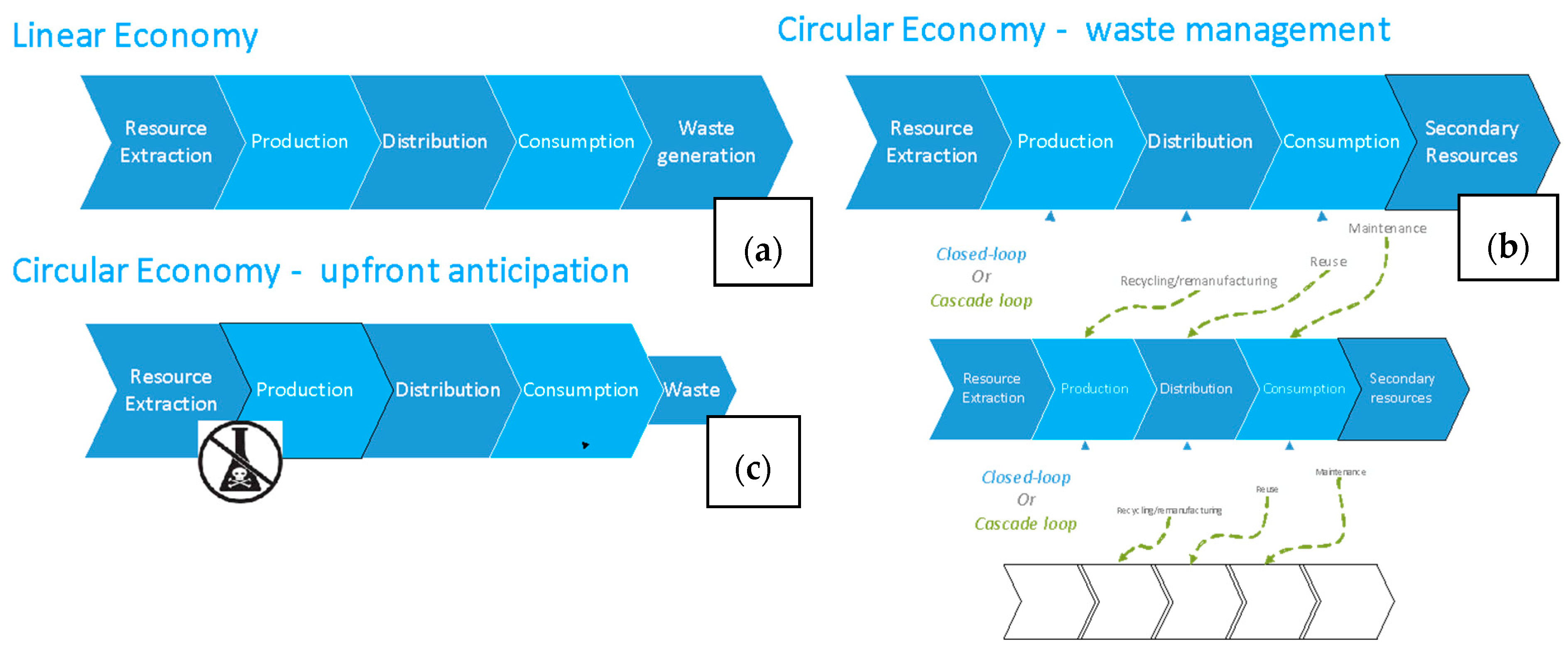
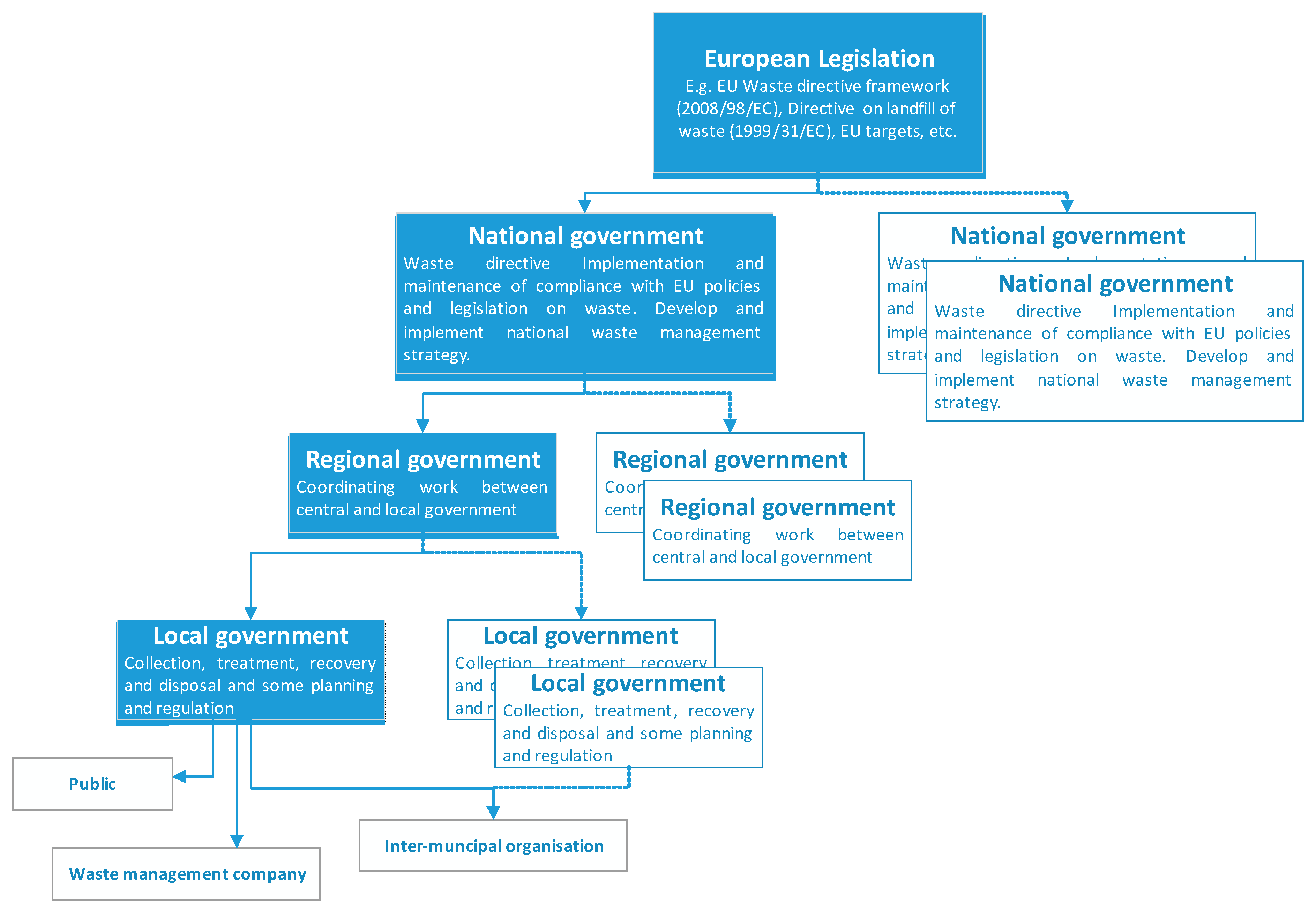
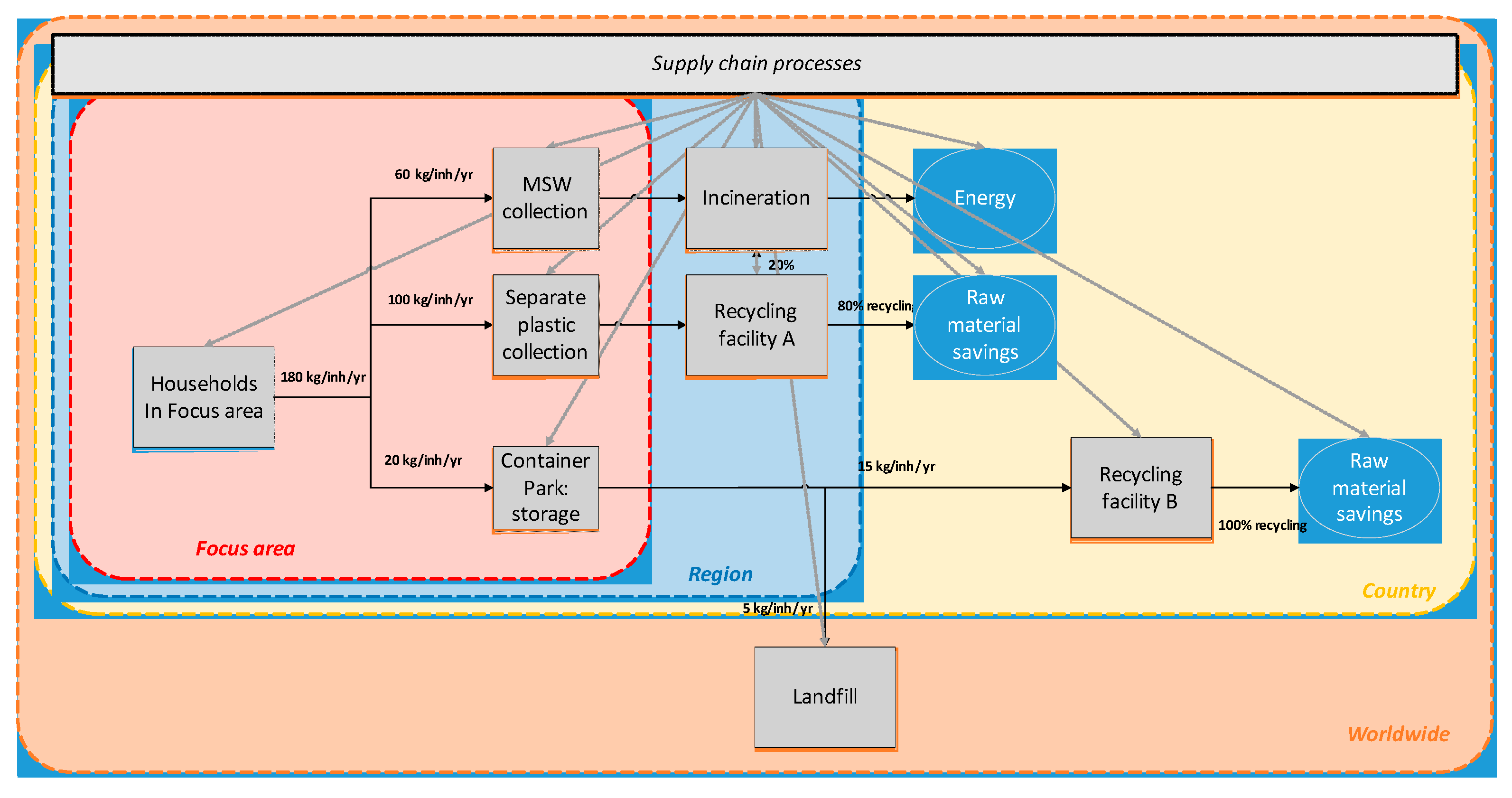
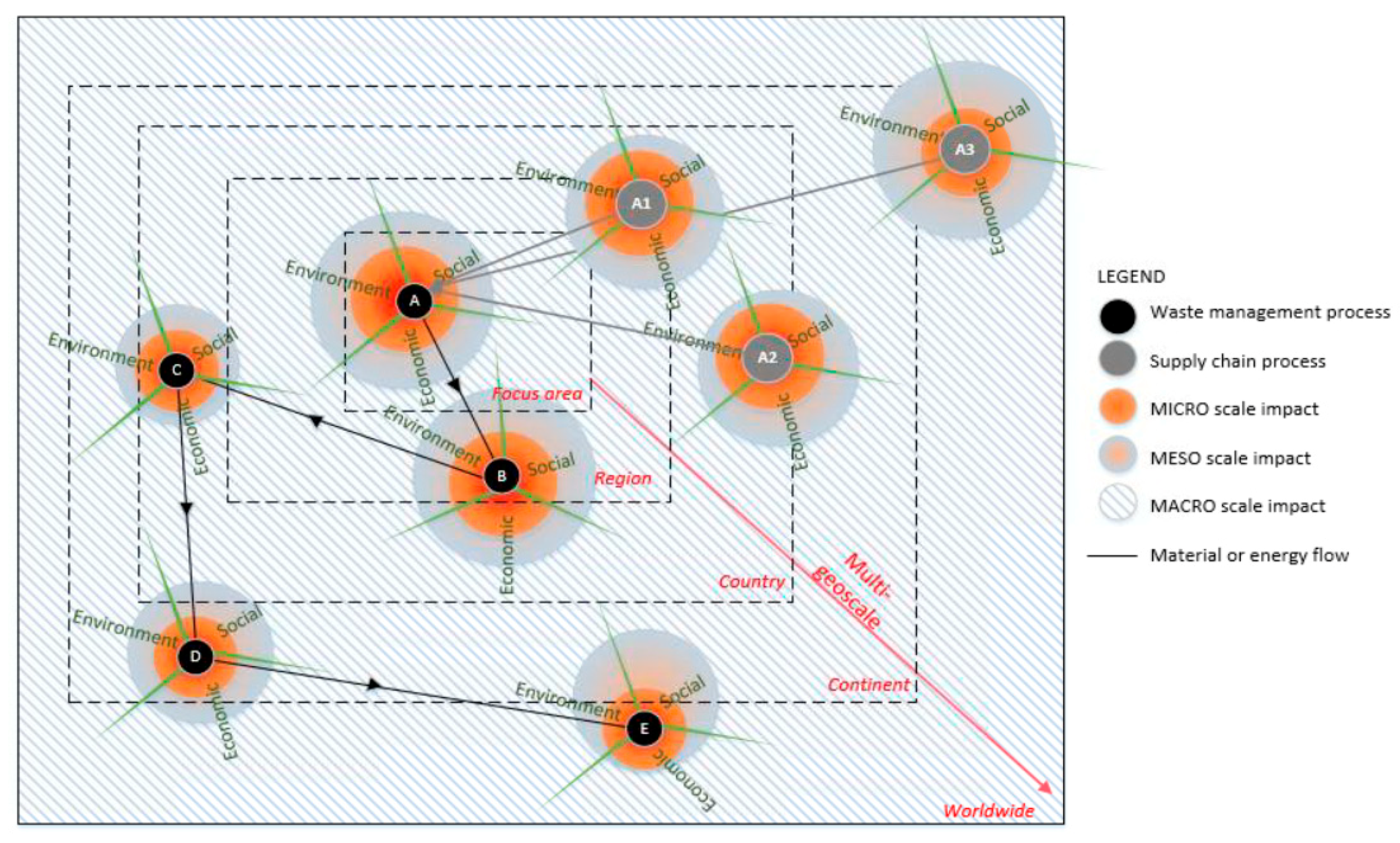

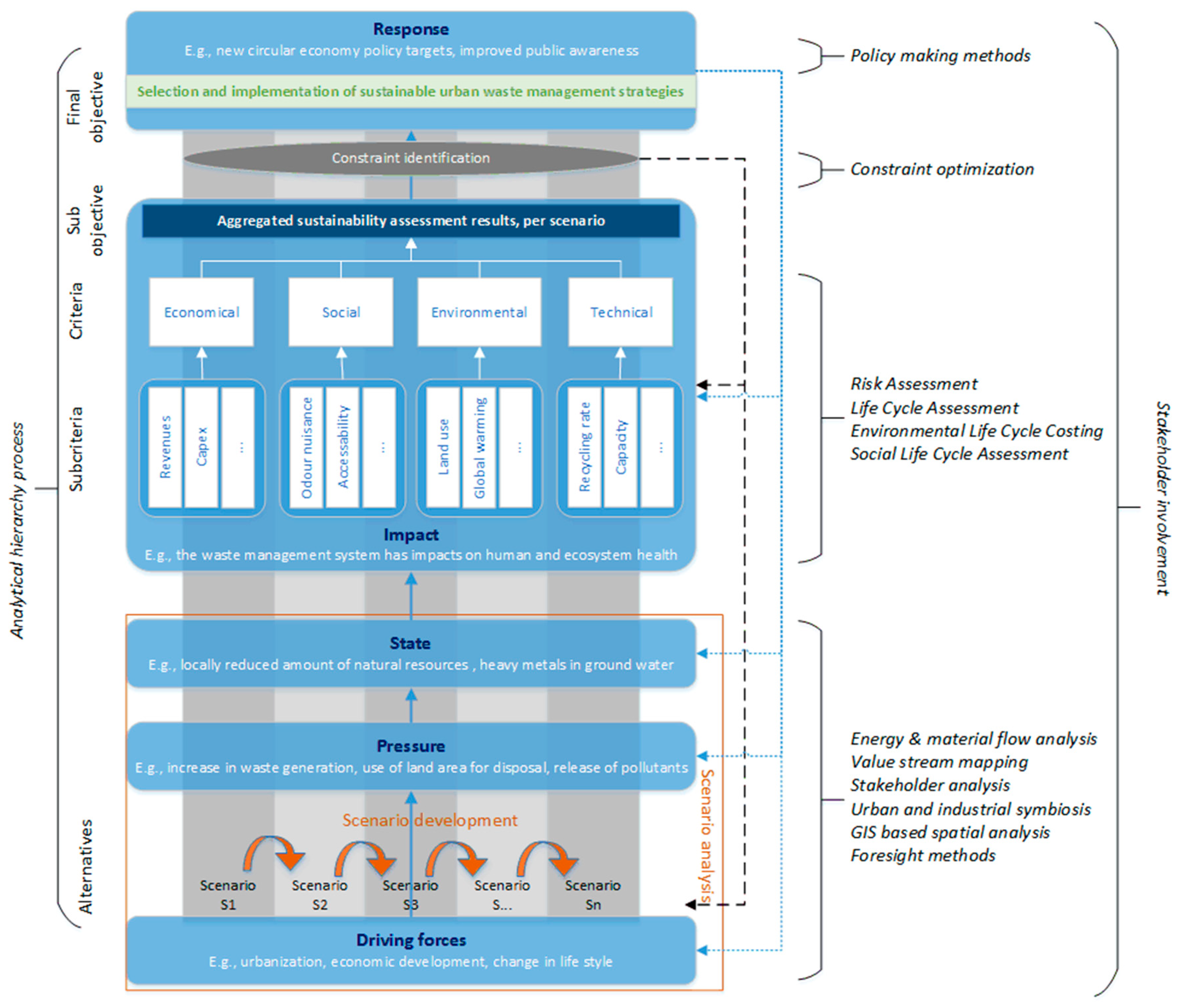
| Reference | Key Objectives | Urban/City Focus | Methods/Tools | Life Cycle Approach | Multi-Dimensional | Temporal Variability | Spatial Variability | Stakeholder Involvement |
|---|---|---|---|---|---|---|---|---|
| [17] | Development of a methodology to design multiple technology bioenergy supply chains and to select the optimum technology, considering economic and environmental sustainability aspects. | No, case study on West Midlands region from the United Kingdom | fuzzy multi-objective modelling, constraint optimization techniques | Partly, considering the main supply chain | Economic (capital investments costs and benefits), Environmental (greenhouse gas emissions), Technological (capacities, etc.) | No | Location of technology and energy demand nodes, Territorial Units for Statistics (NUTS) 3 level | No |
| [18] | A preliminary web-based information system is developed to analyze material flows (resource use, waste generation) both on national and industrial levels. The four-layer framework integrates information on physical flows and economic activities with material flow accounting and waste input–output table analysis. | No | Economy wide Material Flow Analysis (MFA), Input Output analysis | Yes, material life cycle | Environmental | No | No | No |
| [19] | Proposing a framework of sustainability indicators and a metric of sustainability that can serve as a reference for sustainability studies of waste-to-energy systems. | No | Life Cycle Sustainability (LCA), substance flow analysis, Life Cycle Costing (LCC), Social Life Cycle Assessment (SLCA), (life cycle sustainability assessment (LCSA) | Yes | Social, Economic, Environmental | No | No | No |
| [20] | Development of a Sustainable Operations framework to guide projects to make a proper contribution to sustainability without compromising on financial rigor, e.g., by integrating sustainable development (SD) into industrial plant design and operation. | No | LCA, social impact analysis, footprinting, multi-criteria analysis techniques, etc. (not a fixed-set of methods) | Partly, depending on the choice of methods used to address sustainability | Environmental (natural), Social (human), Economic (manufactured, financial capital) | No | No | Study team per project (different backgrounds) |
| [21] | Development of 3-stage consistent framework and application to the assessment and retrofit of several technological options for food waste management. | No | Data envelopment analysis (non-parametric linear programming), LCA, process retrofit | Yes | Environment | No | No | No |
| [22] | Introducing a multi-objective robust optimization model for municipal solid waste management system, by considering all three dimensions of sustainability. | Case study on the Municipal Solid Waste (MSW) management system of the city of Tehran | Multi-objective optimization model, robust optimization approach (uncertainty), constraint optimization, linear programming | No | Economic, Environmental, Social | No | Yes, optimal localization of disposal/recycling plants | No |
| [1] | Development of a multilayer systems framework and scenarios to quantify the implications of food waste strategies on national biomass, energy, and phosphorus cycles, using Norway as a case study. | No | Substance flow analysis (biomass, phosphorous) and energy balances | Partly, considering the main supply chain | Technical (environmental) | No | Specific national data (mass/energy flows) used from Norway | No |
| [23] | This study proposes a novel, conceptual approach that seeks to assess how complex value is created, destroyed and distributed in resource recovery from waste systems. It combines scientific and engineering methods with a socio-political narrative grounded in the systems of provision approach, and provides a comprehensive, analytical framework for making the transition to a resource-efficient future. | No | Value stream mapping, industrial symbiosis | Yes | Economic, Environmental, Social, Technical | No | No | No |
| [24] | This paper presents a framework for examining the most sustainable processing options for green waste valorization in terms of the triple bottom line, People–Planet–Profit | No, case study on the region Flanders in Belgium | LCA, Analytical Hierarchy Process (AHP), multiple objective mixed-integer linear programming, (net present value) | Yes | Economic, Social, Environmental | No | No | Partly, stakeholders’ experiences included |
| [25] | This paper proposes strategic positioning of pollution prevention and clean production projects via design of a sustainable environmental management system, ELECTRE III, that is responsive to regulatory requirements, and is relevant to industry culture and business structure. | No | Multi-criteria decision analysis method (electric iii) | No | Social, Economic, Environmental | No | No | Involving decision makers and experts to define problems, generate alternatives, performance criteria and indicators |
| [26] | Presented in this paper is an integrated ecological economic assessment considering the economic and ecological losses and a sustainability policy-making framework for 31 typical Chinese cities in view of spatial variations based on thermodynamic analysis | Yes | GIS, emergy analysis, LCA | Yes | Environment, Economic | No | Yes, representation of cumulative impacts in terms of emergy performance on a terrestrial map | No |
| [27] | The “Wasteaware” Integrated Sustainable Waste Management (ISWM) indicators framework is described; an innovative combined evaluation approach is proposed in the present paper to deal with the issue of the performance measurement and comparison of UWM services in the context of cities. | Yes, case study based on 12 different cities from the Optimal Territorial Ambit of Palermo in Sicily. | ISWM indicators of Wilson et al., 2015, evaluation approach (electric iii outranking method), multi-criteria analysis in a non-compensative manner | No | Technical-Operational, Environmental, Financial, Economic, Socio-cultural, Policy-legal and Institutional | No | Yes, city-specific data collection. | Consultation process key stakeholders (citizens, local administrators, service providers), face-to-face survey |
| [28] | A waste elimination framework has been suggested as an approach for sustainability in manufacturing environment. The framework contains three consecutive phases: waste documentation, waste analysis, and waste removal. | No | Traditional and dynamic value stream mapping (VSM), root cause analysis, failure mode and effect analysis, AHP, Analytic Network Process (ANP), Data Envelopment Analysis (DEA), … | Partly, root cause-effect chain | Not stated. | Yes, DVSM, time recording | Yes, DVSM, location recording | Brainstorming with experts (root cause analysis) |
| [29] | A Hierarchical Analytical Network Process (HANP) model is demonstrated for evaluating alternative technologies for generating electricity from MSW in India | No | HANP, AHP | No | Technical, Financial, Environmental and risk (criteria, to inform policy makers) | No | Partly, site-specific primary data of the situation India. | WM experts involved (based on questionnaires) to identify weighting factors |
| [30] | This study aimed to establish a comprehensive framework to evaluate industrial and urban symbiosis scenarios. | Yes, Kawasaki City in Japan | Industrial and urban symbiosis, material flow analysis, emergy analysis, life cycle carbon footprint | Partly, carbon footprint | Environment | No | Case study: site-specific data (process flow data + geographical data) | Case study: discussion with stakeholders for data (interviews and surveys) and scenario design |
| [31] | The authors examine the factors that give rise to food waste throughout the food supply chain and propose a framework to identify and prioritize the most appropriate options for prevention and management of food waste. | No | Interviews | Partly, the main food supply chain | Social, Environmental, Economic | Partly, considers temporality of food (waste) | No | Interviews with food waste specialists, they give qualitative information, on which the framework is entirely built |
| [32] | The proposed framework, SWIT (Sustainable Wealth creation based on Innovation and Technology) has been developed to provide multiple businesses of zero-value residue industrial ecology processes, inserted into circular value ecosystems, all managed and governed by a sustainable sharing value system for the benefit of a community. | No | Value stream mapping, MFA, LCA, LCC, SLCA, Environmentally Extended Input Output analysis (EEIO), Cost Benefit Analysis (CBA) | Yes | Economic, Social-Political, Environmental | No | Regional level. | No |
| [33] | A concept and action plan framework is proposed to evaluate issues surrounding the sustainability of solid waste management in Asian countries | No | Situation analysis | No | Political, institutional, legal, technical, (environment, social) | No | Partly, nationally aggregated urban information | Yes, public participation |
| [34] | In this paper, we develop and apply a methodology for stakeholder consultation regarding the selection of Life Cycle Sustainability Assessment (LCSA) impact categories. The methodology is based on decision science concepts and tools with an emphasis on the elicitation of stakeholders’ perspectives depicted in cognitive causal maps | No | LCA, LCC, SLCA, Multiple-criteria decision-making (MCDA), Problem structuring methods, Strategic options development analysis, causal maps | Yes | Economic, Social, Environmental | No | Partly, national level. | Stakeholder involvement for the selection of impact categories (interviews, workshops) |
| [35] | A conceptual sustainability framework for near-to-site variations of cycle technological design (to reutilize waste streams) has been developed. Suitable structure and characteristics for initial technology assessment, specifically for these cycle technologies are presented | No | LCA, material, energy and waste modelling, cost indicators | Yes | Environment, Economic, Technical | No | No | No |
| [36] | The paper presents an indicator set for integrated sustainable waste management (ISWM) in cities both North and South, to allow benchmarking of a city’s performance, comparing cities and monitoring developments over time. The comprehensive analytical framework of a city’s solid waste management system is divided into two overlapping “triangles”—one comprising the three physical components and the other comprising three governance aspects. | Yes | / | No | Economic, Social, Environmental, Governance | No | Partly, city-specific data | Yes, inclusivity (allowing stakeholders to contribute and benefit) |
| [2] | This paper aims to establish a framework for assessing the eco-efficiency of construction and demolition waste management performance through eco-efficiency indicators, based on the particular practice of Hong Kong | No, case study on the region of Hong Kong | Eco-efficiency analysis, LCA, LCC or total cost of ownership, full cost accounting | Yes | Economic, Environmental | No | Partly, can be done on company level to supranational level | No |
| Scale | Length | Area | Description |
|---|---|---|---|
| Micro | 1 m–10 km | 1 m2–100 km2 | Affects a local area |
| Meso | 10 km–1000 km | 100 km2–1,000,000 km2 | Affects a regional/continental area |
| Macro | >1000 km | >1,000,000 km2 | Affect places all over the globe |
| Type of Methods | Method | Main Function in Framework |
|---|---|---|
| Scenario analysis and development | MEFA | Quantifies and visualizes material and energy flows within the different scenarios. |
| VSM | Adds information flows (value) to the different scenarios. | |
| SA | Identifies the stakeholders that are influenced by/able to influence decisions regarding waste management. | |
| UIS | Identifies opportunities to exchange material/energy/waste between urban and industrial areas and supports the development of circular economy scenarios. | |
| GSA | Shapes the scenarios from a spatial point of view and provides information to develop spatially-differentiated CFs for impact assessment. | |
| ForeS | Enables the development of scenarios that are snapshots of the future. | |
| Impact assessment | LCA | Calculates environmental impacts, based on a life cycle perspective. |
| ELCC | Calculates economic impacts, based on a life cycle perspective. | |
| SLCA | Calculates social impacts, based on a life cycle perspective. | |
| Prioritizing | AHP | Helps in prioritizing among different scenarios based on selected criteria. |
| CO | Useful to analyze conflicting objectives and to systematically identify efficient trade-offs. | |
| Policy making | Polmak | Provides a better understanding of the policy making process. |
| Stakeholder involvement | SI | Multi-stakeholder involvement, i.e., integrating their ideas, knowledge, preferences, concerns, etc., is crucial in every step of the framework. |
| Structuring | DPSIR | Provides the overall structure of the framework. |
© 2018 by the authors. Licensee MDPI, Basel, Switzerland. This article is an open access article distributed under the terms and conditions of the Creative Commons Attribution (CC BY) license (http://creativecommons.org/licenses/by/4.0/).
Share and Cite
Taelman, S.E.; Tonini, D.; Wandl, A.; Dewulf, J. A Holistic Sustainability Framework for Waste Management in European Cities: Concept Development. Sustainability 2018, 10, 2184. https://doi.org/10.3390/su10072184
Taelman SE, Tonini D, Wandl A, Dewulf J. A Holistic Sustainability Framework for Waste Management in European Cities: Concept Development. Sustainability. 2018; 10(7):2184. https://doi.org/10.3390/su10072184
Chicago/Turabian StyleTaelman, Sue Ellen, Davide Tonini, Alexander Wandl, and Jo Dewulf. 2018. "A Holistic Sustainability Framework for Waste Management in European Cities: Concept Development" Sustainability 10, no. 7: 2184. https://doi.org/10.3390/su10072184
APA StyleTaelman, S. E., Tonini, D., Wandl, A., & Dewulf, J. (2018). A Holistic Sustainability Framework for Waste Management in European Cities: Concept Development. Sustainability, 10(7), 2184. https://doi.org/10.3390/su10072184






